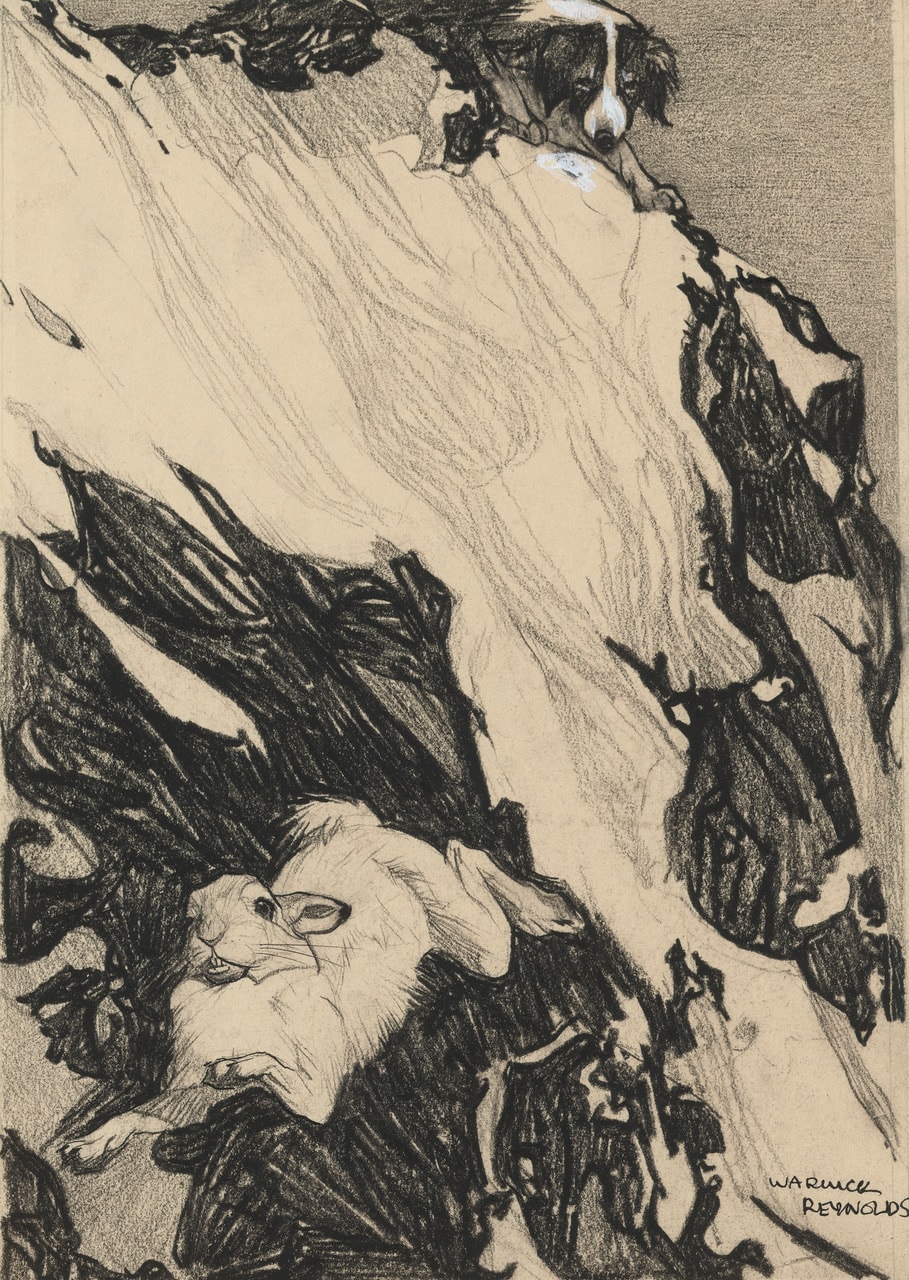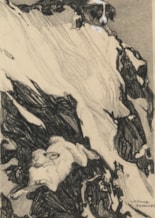Warwick REYNOLDS
(London 1880 - Glasgow 1926)
Blue Hare
Sold
Pencil and charcoal, with touches of white heightening.
Framing lines in pencil.
Signed WARWICK / REYNOLDS at the lower right.
Inscribed where none dare follow and Blue Hare in the lower margin.
Inscribed and numbered FAS 18916 [crossed out] 3655 on the verso.
232 x 160 mm. (9 1/8 x 6 1/4 in.) [image]
242 x 173 mm. (9 1/2 x 6 3/4 in.) [sheet]
Framing lines in pencil.
Signed WARWICK / REYNOLDS at the lower right.
Inscribed where none dare follow and Blue Hare in the lower margin.
Inscribed and numbered FAS 18916 [crossed out] 3655 on the verso.
232 x 160 mm. (9 1/8 x 6 1/4 in.) [image]
242 x 173 mm. (9 1/2 x 6 3/4 in.) [sheet]
In an account of the artist, published the year after his death, it was noted that ‘For many years Warwick Reynolds has been recognised as the illustrator par excellence of the animal story, and month by month the public has learnt to look for his vivid pictorial accompaniments to the prose of such writers as the late F. St. Mars and Mortimer Batten. Indeed, his output was amazing, and covered not only a wealth of illustration, but paintings and etchings that delighted the public and amazed his brother artists...It was, undoubtedly, the vogue of the animal story that eventually gave him his due and placed him in the front rank of illustrators…Pre-eminently a depicter of action, his more reposeful animal studies show quite as much fidelity as his most desperate duel scenes, or life and death races…[He was] a man who excelled – and revelled – in his work.’
This is a preparatory study for one of Reynolds’s full-page illustrations – with the caption ‘The Blue Hare – ‘Where None Dare Follow.’’ - in Harry Mortimer Batten’s book Habits and Characters of British Wild Animals, published in 1920. The blue hare or mountain hare (lepus timidus) is found in mountainous and polar regions across northern Europe and Asia. It is the only hare native to Britain, and is indigenous to the Highlands of Scotland. While their fur is a bluish-grey in summer, mountain hares change their colour in winter, turning their pelage white to be better camouflaged against the snow. As Batten writes, ‘Two thousand feet is probably the topmost altitude of the brown hare’s range…Above that the territory is sacred to the blue. Blue hares…observe no fixed rule as to boundary. The heights are theirs undividedly, but they are quite at home in the valleys…The blue hare is nothing like so speedy, nor is it so resolute in flight, as is the brown. A good sheep-dog can run it down – often without any great resistance on the part of the hare…a blue hare will den up readily if hard pressed – seeking safety in a cranny among the rocks or in a disused rabbit-burrow.’
This is a preparatory study for one of Reynolds’s full-page illustrations – with the caption ‘The Blue Hare – ‘Where None Dare Follow.’’ - in Harry Mortimer Batten’s book Habits and Characters of British Wild Animals, published in 1920. The blue hare or mountain hare (lepus timidus) is found in mountainous and polar regions across northern Europe and Asia. It is the only hare native to Britain, and is indigenous to the Highlands of Scotland. While their fur is a bluish-grey in summer, mountain hares change their colour in winter, turning their pelage white to be better camouflaged against the snow. As Batten writes, ‘Two thousand feet is probably the topmost altitude of the brown hare’s range…Above that the territory is sacred to the blue. Blue hares…observe no fixed rule as to boundary. The heights are theirs undividedly, but they are quite at home in the valleys…The blue hare is nothing like so speedy, nor is it so resolute in flight, as is the brown. A good sheep-dog can run it down – often without any great resistance on the part of the hare…a blue hare will den up readily if hard pressed – seeking safety in a cranny among the rocks or in a disused rabbit-burrow.’
Born in Islington, Warwick Reynolds was the son of a cartoonist and illustrator of the same name. He studied in London at the Grosvenor Studio and the St. John’s Wood Art School, and in 1895 began working as a magazine illustrator, eventually contributing to such publications as The Idler, Pearson’s Magazine, The Quiver and The Strand Magazine, among others. Reynolds had a particular interest in depicting animals, and made studies at the London Zoo at Regent’s Park between 1895 and 1901, where he earned an artist’s ticket at the age of thirteen. He also illustrated a number of books on wildlife themes, including H. Mortimer Batten’s Habits and Characters of British Wild Animals, published in 1920, and Dwellers in the Jungle by Gordon Casserly, which appeared in 1927. In 1906 Reynolds settled in Glasgow, where he was employed as a staff artist for the Daily Record newspaper. He lived and worked in Glasgow for the remainder of his career, apart from a year spent in Paris in 1908, where he enrolled at the Académie Julian. He made drawings of animals at the Edinburgh Zoo, and exhibited his work at the Royal Academy, the Royal Glasgow Institute of Fine Arts and the Royal Scottish Academy. He died in 1926 at the age of forty-six, and the following year memorial exhibitions of his work were held at the Sporting Gallery in London and the Wellington Art Galleries in Glasgow.
Provenance
The Fine Art Society, London
Private collection.
Private collection.
Literature
H. Mortimer Batten, Habits and Characters of British Wild Animals, London and Edinburgh, 1920, illustrated between pp.208-209.




